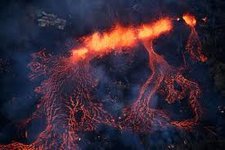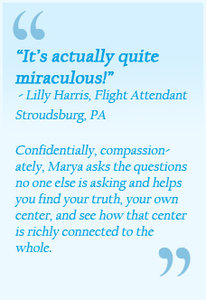Kilauea Volcano: BODY OF A GODDESS

This spring is different. A cloak of vog from Kilauea Volcano blocks out the sun for half the day, even 100 miles away from the bubbling caldera. We taste ash on our tongues and the eyes sting with gases and dust particles.
But the annoyance of ash is mild compared to our neighbors in Puna. Some are living in cars, tents, and under trees, coughing and wheezing as they shelter as much as possible from the devastating effects of our beloved Pele giving birth to new Earth.
“There’s not a lot of words to capture a gradual, slow-developing disaster like this,” says volcanologist Erik Klemetti.
My Puna friend J. put it aptly though: “Pele is growing a whole new vagina, it’s a new caldera right there in the middle of the subdivision.”
Humans have long referred to their own anatomy when describing landscape features, but the mysterious “aliveness” of molten lava flowing in your backyard perfectly embodies attributes of the Hawaiian volcano goddess, Pele.
In indigenous tradition, all aspects of volcanic creation and destruction, from lava rivers — tongues — that alter the landscape to the red ‘ohelo berry bushes that colonize recent lava flows, are considered kinolau: literally, “body forms” of the volcano deity.
“We’re on alert. Ready to go,” she says. “I packed my daughter’s paintings up and stored them in Hilo. So they’re safe.”
“But what about you?
“Oh, we’re fine.”
Since the eruption began May 3 on Kilauea’s East Rift Zone, 41 homes and 41 other structures have been destroyed. New lava has covered at least 2,200 acres. Their nine-acre farm is endangered, seismic quakes occur nearby on the summit at a rate of 250 quakes every 24 hours, and steam explosions are throwing fiery 10-ton boulders 13,000 feet into the air. Sulphur dioxide emissions are continuous. They burn the airways and cause choking, gasping, and eventually, death.
Considering all that, being fine is stoic to say the least, heroic too. Organic farmers, she and her husband had settled into the southeast part of Hawaii Island with a wave of adventurers, environmentalists, and anti-war activists in the late 20th century. Self-described “Punatics,” they are frontiersmen and women really. Relinquishing the values of the industrialized, war-fond, techno-addicted U.S., they headed “back to the land,” to live sustainably with little impact on the Earth.
They are born rebels. So I have to ask, “You’re ready to go, right, if they tell you to evacuate?”
“We’re not thinking that way. We’re thinking the flows into the ocean are bypassing us. We’re in a kīpuka.”
“True,” I say. Puna is cherished as both kinds of kipuka.
It’s a “cultural kīpuka” — an oasis where Hawaiian cultural knowledge and indigenous values are learned and renewed, where sustainable ways of life that honor the Earth and rely on its animism – its Soul – can flourish.
Geologically, a kīpuka is a raised island of native forest and plants set in the middle of a recent lava flow. Because of its elevation, a kipuka is spared burial and incineration by rivers of fire.
Hawaiians say a kipuka is an oasis saved from Pele’s embrace.
Puna has both kinds of kipuka: sanctuaries that escape the destructive forces of the volcano and also safe spaces for the lively practice of cultural arts, agriculture, and lifestyles.
Living in a kipuka could be protective, but I was still concerned.
“Do you have an evacuation plan?”
“Oh, yes. We could be out of here in a few minutes. If it weren’t for the animals.”
“Can you move them?”
“Not yet. I don’t’ think we’ll need to. No worries!”
No worries? Hadn’t she measured all the dangers? “But there’s the Puna Geothermal plant (PGV). If lava ruptures the wells at the plant, it could release deadly hydrogen sulfide.”
“It won’t. The lava hardened into a fat wall before more magma entered the site. It stopped just outside of it and a wall of lava stone formed. It stopped. Great, huh?”
“Fantastic,” I say, thinking how cool it is for her to stay cool in all the chaos. “But I just heard lava flowed into the PGV property. No one knows what exactly will happen there.”
“Plus, they’ve moved all the hazardous materials from the site,” she countered. “We’re so much better off than Leilani Estates and Lanipuna.”
My heart filled with tears thinking about people who had lived and gardened around their homes for 30 years and then Pfrft! Underground. Underlava. Suddenly under.
Suddenly it was all Pele’s. Many already knew it was never NOT Pele’s.
That was the central argument by the local Hawaiians and Pele Defense Fund who protested for years against the building of the PGV. Pele hasn’t offered her magma, nor her steam power, they said. Industrialists would have to drill down into the mantle, the hot magma of the planet’s interior. They would open pockets, bore through natural lava tubes, rearrange Pele’s viscera, change her breathing patterns. They were basically fracking, the defenders warned. Earthquakes could result.
In 2007, Puna Geothermal Venture, PGV, drilled 2.5 kilometers into Hawaii Island and broke through to the mantle. This last series of Earthquakes started on May 1, 2018, and have continued to destabilize Puna.
“What about the vog now?” I say, trying not to think of the PGV. I didn’t want to alarm her. “Why don’t you just leave? Come stay with me. The Sulphur dioxide must be awful.”
“It’s as clear as a bell. The sky is blue. How is it in Kona?”
“It’s like dusk at 2:00 in the afternoon.”
“It’s sunny all day over here. Maybe you should come over here to get out of the vog?” We both laughed. Air quality readings had Puna at 20 PM and Kona at 75 PM (Particulate Matter). Tradewinds periodically bring clouds of volcanic gases and particles in a curve west and north up our coast to blanket the coastline with cooling, toxic clouds. On some days, the trades bring clear sunshine and pristine air. Now, the vog is gray and thick, snubbing out the sun for long hours.
J. lives only six miles and makai of the sizzling magma flows to the East. I had called her to see what I could do to help. But here she was, lifting me up, making light.
While we struggle to help families and children displaced by the destruction, making light is both the hardest and perhaps the most important thing we can do.
The biggest killer is not the volcanic magma, sizzling through tree-lined neighborhoods, as lethal as they are. It’s not poison gases, laze, or vog, though they too are harsh teachers.
The big killers are not nuclear war threats, or the US president, or even environmental degradation. The biggest killers are the thought-feelings that lead to actions that lead to these maladies. They can also be the biggest saviors.
The thought-feelings that make up our stories are blueprints for our future behaviors. The story we make up about what’s happening now is a preview of coming attractions. At the level of energy and dreaming, everything affects everything. Present feelings and thoughts create future actions.
The biggest savior can be choosing the story we dwell upon. People with a soul connection like my friend J. have fostered gratitude and forgiveness to the point where their attitude of grace precedes and surrounds events with a positive frame.
Like others from Puna, she had been angry. In previous conversations and protests about PGV, she argued that we must not drill into the heart of the volcano. Don’t rape Pele, the defenders pleaded. Now that the damage has been done, with eleven wells drilled deep into the volcano’s core to tap Her power, it’s not just positive or wishful thinking that Puna residents need. They need food, medicines, tents, new places to live, and more. At some point, they may find forgiveness for a terrible wrong thrust upon them. For now, people are in survival mode. It’s enough to live day to day, to cultivate the endurance that helps them persist, and to remember gracefully — “this too shall pass.”
Events gain their significance by the energy we place on them. If we are quick to forgive and move on, we anchor ourselves in positive experiences and benefit from a higher frequency of energy, so we can move toward the futures we choose.
To support and help protect Puna, please don’t send worries. Be like the Punatics! Use your thoughts, visions, prayers, and empowerments to honor the ancient natural forces and visualize the best outcomes. As Pele continues to make her majesty known, we are indeed in unmapped territory.
Lava from the Kilauea volcano has crept onto the Puna Geothermal power plant property, but we are envisioning the Fire Goddess making a wall of hardening lava to prevent it from seeping into the deep wells and causing an even more tragic situation! Please use your powers of visualization to see it so.
Please join me in thanking Pele! Mahalo, Fire Goddess, for your protection!
Envision that this protective wall continues to hold! Keep the vision of safety for our Puna neighbors in your mind. We will remember the terror and displacement these events are creating for people; let’s be sure to do whatever we can to prevent any potential future man-made earthquakes from ever happening again.
Thank you again for all your good thoughts and feelings that traverse the stratosphere and land right at the point needed to help people cope. Envision the people of Puna and the volcano goddess Pele at peace again. Rather than you sending light, see all beings, especially our Puna neighbors, empowered and full of light You serve them better by visualizing their inner light radiating fully, bright and strong, making rainbows that glimmer and dance in the
Though it’s voggy and the breathing problems are real, we are safe. Tradewinds shift frequently. Gratitude listing can make even the worst situation into good medicine. Gratitude for what’s going right in the world raises your sails to catch the higher winds!
Material support is also still needed. Help Puna! Please contribute to Puna Pu’uhonua (Puna Refuge) at https://www.gofundme.com/puuhonuaopuna


